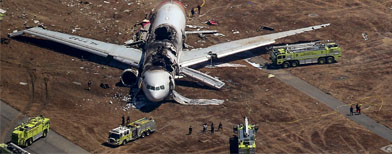 .
.
Asiana Airlines on Monday confirmed that the pilot flying the Boeing 777 that crashed in San Francisco was in training, opening the possibility of human error as a cause of the deadly accident.
Two teenage Chinese girls were the only fatalities in the explosive crash Saturday, though six of the 307 people aboard the flight remained in area hospitals in critical condition.
Chinese state media identified the two dead passengers as Ye Mengyuan, 16, and Wang Linjia, 17, high school classmates from eastern China's Zhejiang province.
One of the girls may have been run over by an airport fire engine rushing to the scene, San Francisco Fire Chief Joanne Hayes-White told reporters. White did not identify the victim.
"As it possibly could have happened, based on the injuries sustained, it could have been one of our vehicles that added to the injuries, or another vehicle," Hayes-White told the San Francisco Chronicle.
San Mateo County Coroner Robert Foucrault told the newspaper that the other girl appeared to have died from injuries suffered as she was hurled out of the plane when its tail broke off in the crash.
The two friends were coming to visit Stanford University, just south of San Francisco, and to attend a summer camp at a local Christian school, the Chronicle reported.
Asked about the accidental death report, Beijing's foreign ministry spokeswoman Hua Chunying said: "We are still trying to verify the situation."
US investigators said Sunday that the Asiana jet was traveling much slower than recommended as it attempted to land.
The flight data recorder showed that as the Boeing 777 approached the runway its pilots were warned that the aircraft was likely to stall and asked to abort the landing.
The request to abort was captured on the cockpit voice recorder 1.5 seconds before the plane crashed, said National Transportation Safety Board chairwoman Deborah Hersman, who is leading the probe.
The plane was landing at a speed well below the recommended 137 knots, Hersman said.
Her announcement came minutes after a video obtained by CNN confirmed that the aircraft clipped a seawall short of the airport runway and skidded on its belly.
The footage showed the plane with its nose up and its rear hitting the ground. The plane then hit the tarmac, abruptly bounced upward, and spun around 180 degrees. The plane's tail section was torn off in the crash.
The plane's low speed triggered an automatic device that warns pilots the plane is about to stall. The warning came four seconds before the crash -- 2.5 seconds before one of the pilots tried to abort the landing.
Analysts said the pilot's request came too late.
In Seoul on Monday, Asiana said pilot Lee Kang-Kuk had 43 hours of experience in piloting the 777 and was still undergoing training, although he had more than 9,000 hours of flight time experience.
"It's true that Lee was on transition training for the Boeing 777," an Asiana spokeswoman told AFP. However, he was accompanied by an experienced trainer, who acted as co-pilot.
Choi Jeong-Ho, the head of South Korea's transportation ministry's aviation policy bureau, was defensive when he spoke to reporters about the pilot.
"We cannot conclude the accident was caused by a pilot mistake. Whether there was a pilot mistake can be confirmed after all related data are analyzed and inspected," Choi said.
On Sunday Asiana Airlines CEO Yoon Young-Doo apologized for the incident, and said that the plane, which was bought in 2006, had no known mechanical problems.
Asiana Flight 214, which originated in Shanghai and stopped in Seoul, and had 291 passengers and 16 crew members aboard.
In total, 123 people aboard the flight escaped unharmed, US officials said.
Several of the injured were still in critical condition or unconscious, the San Francisco General Hospital said.
Doctors saw "a huge amount of spine fracture, some of which include paralysis," Margaret Knudson, interim surgery chief at the hospital, told reporters.
The twin-engine Boeing 777 is one of the world's most popular airplanes used for long distance flights.
According to aviation safety databases, the two dead teens are the 777's first fatalities in the plane's 18 year of service.
It was the first deadly Asiana passenger plane crash since June 1993, when one of its Boeing 737s slammed into a mountain in South Korea, killing 68.
Asiana's share price ended down nearly six percent on Monday as investors digested the impact of the accident.
Huge insurance payouts to victims and for the aircraft could raise future premiums and increase the company's financial burdens.
Aviation experts however said the damage to its business could be limited, as South Korea's number two airline has spent years building a reputation for safety and quality.

0 comments:
Post a Comment